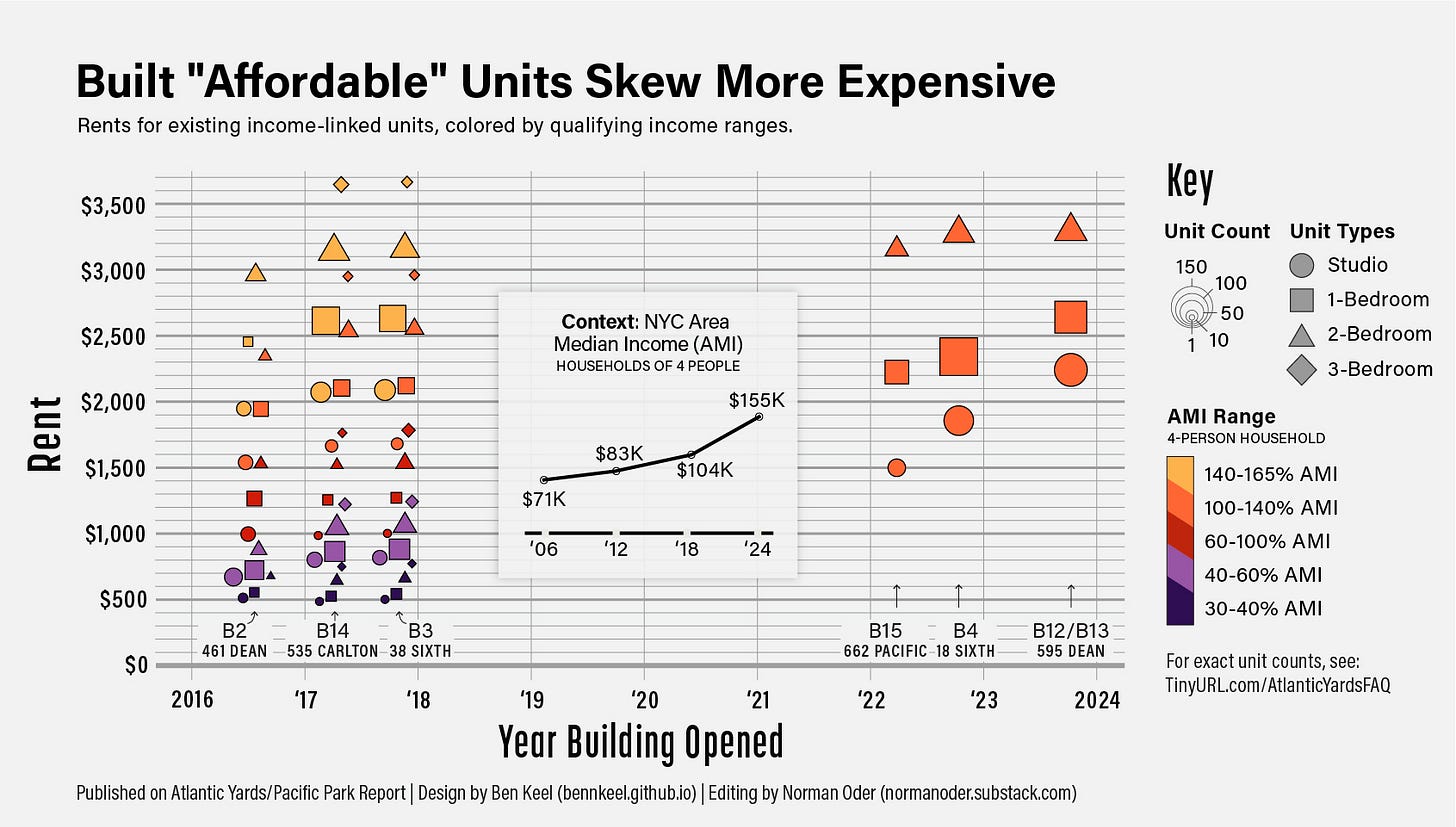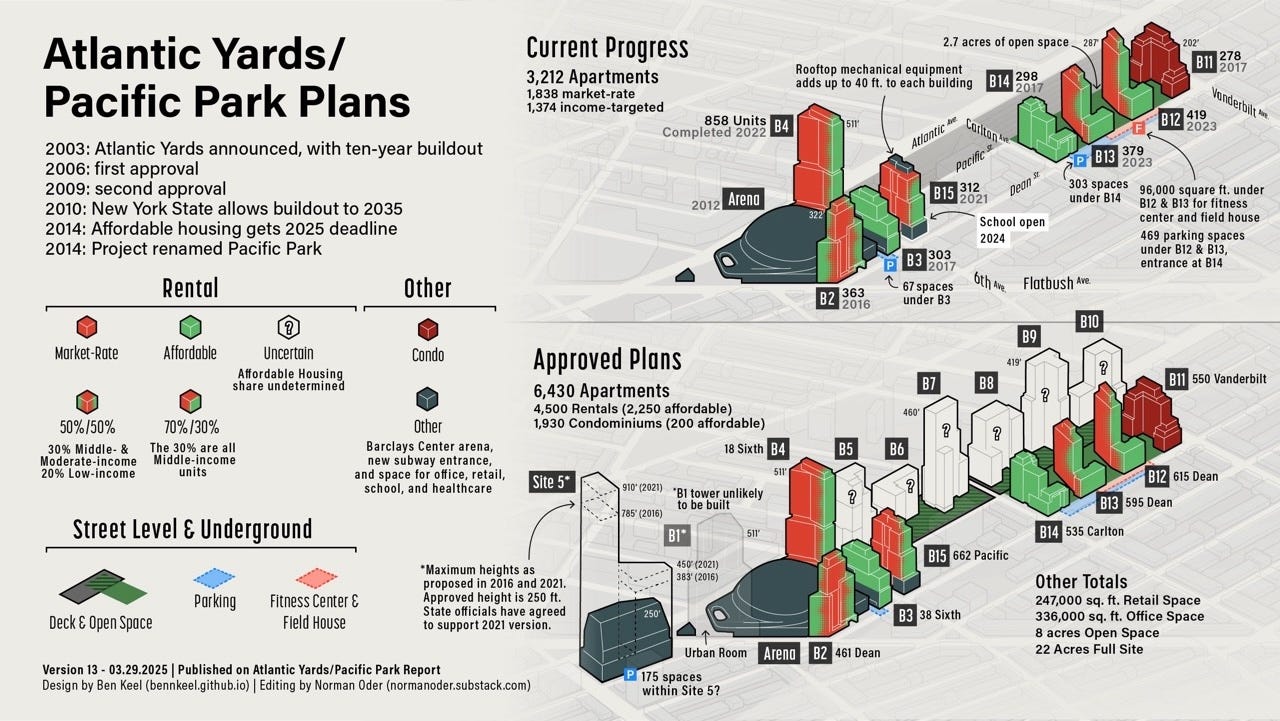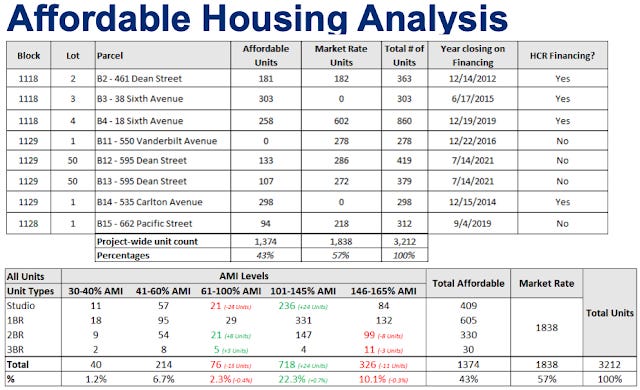Would "Mayor" Cuomo Boost Potential Cirrus Deal for Atlantic Yards?
Candidate backs construction union partnership with "mission-driven" (?) Cirrus Real Estate, which has wider union support for "workforce housing" in Pacific Park plan.
Former New York State Governor Andrew Cuomo, currently the frontrunner in the polls for Mayor, on April 14 released his 29-page housing plan (link), which generated scorn for some incoherence (bad proofreading) and reliance on ChatGPT for research.
While it has all the care of the graphic design exhibited in the screenshot below, but it’s still worth a look, since the breadcrumbs lead to… Atlantic Yards/Pacific Park.
Someone--and I'd bet it's the construction trade unions who've endorsed him--seems to have nudged him to recognize the Brooklyn megaproject. In a section titled "Incentivize Development in Transit-Rich Corridors," the plan states:
The MTA also owns underutilized properties like large rail yards and maintenance facilities that can be redevelopment for mixed-use. This includes the construction of decks like those at Hudson Yards and Pacific Park. Working with the State to unlock this real estate for housing development can enable thousands of new units.
That's small beer, since it doesn't address who'd pay for the deck. However, another section leads deeper, albeit indirectly, to Atlantic Yards/Pacific Park, to a plan that has not yet formally emerged.
Workforce housing
Cuomo pledges additional capital for “affordable housing,” defined as aimed at households earning no more than 60% of Area Median Income, or AMI. That level, considered low-income, is a narrower category than “affordable” when it simply means “income-targeted.”
Cuomo also pledges to develop workforce housing between 80% and 120% of AMI. That's moderate- to middle-income, perhaps not much better--given rising AMI, and commensurate rents--than the units produced at 130% AMI in the last four Atlantic Yards/Pacific Park towers.
The Cirrus connection
A partnership announced by Mayor Eric Adams last year is invoked in Cuomo’s plan:
That is why one approach supported by Governor Cuomo is the partnership between the New York City Building and Construction Trades Council [NYC BCTC] and the Cirrus Real Estate Partners. This initiative will use up to $400 million dollars [sic] in union pension funds to create workforce housing and good-paying jobs. As mayor, Governor Cuomo will look to expand this partnership and others like it, get shovels in the ground, and create not just new housing units for the middle-class, but also union jobs...
Note that, while Cuomo has not (yet) been endorsed by the NYC BCTC, he has been endorsed by several of its affiliated unions.
The vague Cirrus/BCTC plan
As reported Feb. 1, when Related Companies pulled out of a pending joint venture to develop six stalled Atlantic Yards/Pacific Park sites, Cirrus was said to step in.
However, it couldn't be a full replacement, since that it's not a permitted developer, which, according to project documents, is an entity that has at least ten years of experience—or retains a construction manager with that experience—in developing and building “high-rise residential office, hospitality and/or mixed use projects in an urban environment.”
Or, alternatively, an entity “reasonably acceptable” to Empire State Development (ESD), the state authority that oversees/shepherds the project.. Which leaves some leeway.
The joint venture involves creditors for $286 million in loans: the EB-5 immigrant investors, Fortress Investment Group, and the U.S. Immigration Fund, which recruited investors under the EB-5 investor visa program and somehow now holds a stake in the collateral.
The collateral: six sites, B5-B10, which require a deck over the MTA’s Vanderbilt Yard before vertical construction.
As Related exited, the USIF in January announced a new partnership with Cirrus Workforce Housing Advisors. Cirrus’s initiative was announced by Adams March 8, 2024 as part of a partnership to build "workforce housing," using $100 million from Cirrus and from union pension funds, with a goal of $400 million.
That's not a small number, but the platform and six towers presumably would need well more than $400 million in equity.
An April 9, 2024 filing with the Securities and Exchange Commission for Cirrus Workforce Housing Fund I, LP, indicates that, of a total offering amount of $400 million, they had raised $102.2 million from unspecified investors, leaving $297.8 million remaining. That of course could change.
In more than a year since that announcement, and despite stated BCTC hopes that Cirrus projects would break ground in 2024, nothing has been announced. That might make Atlantic Yards/Pacific Park the first such deal if and when it emerges.
How affordable, really?
Atlantic Yards, at least as promised in the 2005 Affordable Housing Memorandum of Underestanding, would have too much low-cost housing to meet the partnership's announced goal to invest in developments with units from 80% to 140% Area Median Income (AMI).
Only 354 of 1,374 units (18.5%) built so far are low-income, below 60% of AMI, despite a pledge that 40% of them should be.
The Real Deal cited a press release in which Cirrus and USIF said they seek “greater affordability than originally proposed” for Atlantic Yards, but wouldn't provide details, as the affordability levels and unit count would result from negotiations with New York State.
That hints at the plan floated in 2023 by Greenland USA, the current master developer, to rescue Pacific Park by adding significantly more square feet, essentially free land, while promising more total below-market units, albeit after extending the pending May 31, 2025 deadline for the 876 (of 2,250) remaining affordable units.
Alternative ways to make a Cirrus Workforce Housing Partners deal work, according to last year's mayoral press release, would be to partner with the city's Department of Housing Preservation and Development (HPD) and the New York City Housing Development Corporation. Both would be responsive to a mayor's priorities.

A recent LinkedIn ad from Cirrus for an Analyst, Workforce Housing noted a requirement to pursue workforce and affordable housing finance programs including NYC HPD Mix and Match.
In the latter, 40%-60% of the units are low-income, affordable to households earning up to 80% of AMI, while the remaining apartments would be affordable to moderate- and/or middle-income households earning up to 120% of AMI, with a range of affordability tiers required. A subsidy from New York City would be paired with other public and private sources.
Surely Cuomo is on board. Similarly, incumbent Mayor Adams, running as an independent, has no campaign policy positions, presumably would be on board. It would be interesting to see how other candidates see it. After all, the devil is in the details.
Deal already has backers
Though only a vague alliance has been announced, with no public discussion of affordability and scale, union backers were lined up by mid-February. Such support echoes early union backing for Forest City Ratner’s promises of housing and jobs.
The labor publication Labor Press on Feb. 18 published New Proposal for Affordable and Workforce Housing at Pacific Park Gains Strong Union Support, citing the Building and Construction Trades Council of Greater New York, 32BJ SEIU, United Federation of Teachers, Uniformed Firefighters Association, and the New York City District Council of Carpenters.

The initiative, according to Labor Press, is "designed to expand affordability while ensuring that union labor is used at every stage—from construction to long-term building maintenance."
That, of course, was the original Atlantic Yards pledge. The project gained public and union support because of Bruce Ratner's promise to build union, though that was attenuated by a plan for modular construction, with union jobs at lower wages. So "union built" is nothing new.
What's affordable?
Details remain vague. The Pacific Park project, according to the article, "expands on previous efforts by offering a broader range of housing options across income levels, ensuring that both affordable and workforce housing are prioritized to meet the needs of low- and middle-income New Yorkers, including essential workers."
Well, it all depends on what "previous efforts" means: the level of affordability long promised (40% of the below-market units low-income) or the level delivered (18.5%)?
In other words, would a return to the original promise be considered progress? Not quite, since there's a cost to delay, as the baseline to calculate affordability keeps rising, given rising AMI.
Note that, while Cirrus was announced on Jan. 31 as being part of a joint venture, it only registered with the state as a lobbyist on March 1, which doesn't allow for much time to negotiate a deal. By contrast, Related Companies, which has far more experience and capacity than Cirrus, lobbied Empire State Development for several months last year.
Reasons for doubt
This nearly 22-year history of Atlantic Yards has taught us that promises deserve skepticism. For example, the affordability pledge in the Housing MOU was attenuated by the project’s guiding Development Agreement, which defined “affordable housing” far more loosely.
Even if the promises are seemingly locked in, such as in the 2014 settlement agreement with the coalition BrooklynSpeaks that set the new May 31, 2025 deadline for affordable housing, such “ironclad” commitments may be revised. Perhaps we’ll learn more in the next month.
Affordability questions
The Labor Press article quoted Mike Mulgrew, President of the United Federation of Teachers:
“This project is a critical step forward in addressing New York City’s affordability crisis for middle-income families. Cirrus’ mission-driven approach is exactly what’s needed to ensure that workers essential to our city—educators, firefighters, and police officers—can afford to live where they work. Their commitment to union labor and to building a more affordable city makes this a project that truly reflects New York City’s values.”
This raises a question: would the future Atlantic Yards/Pacific Park deal deliver below-market housing in most or all of the remaining units? Or would it simply be a significant share?
Wouldn't simply conforming to the new 485-x tax break, which requires 25% affordability at an average of 60% of AMI, go beyond Cirrus’ original workforce housing pledge?
Would Cirrus seek, as Related apparently did, a recreation of the 421-a tax break, a better deal for developers than 421-a?
One challenge with 485-x is high wage requirements for projects larger than 99 units. Then again, in the press release last year, Gary LaBarbera, president of the Building and Construction Trades Council of Greater New York and Vicinity, said the Cirrus deal would lead to “affordable workforce housing under negotiated Project Labor Agreements”—i.e., customized wage rates premised on steady work.
“Mission-driven”?
Apparently the willingness to partner with labor unions can allow a private fund seeking “superior” returns to qualify as “mission-driven.” From the Labor Press article:
Cirrus Executive Joseph McDonnell added, “At Cirrus, we believe that housing should be built for the people who make New York City work, not just to serve the bottom line of developers. Our mission-driven approach will put affordability at the forefront, ensure union labor is used, and deliver on the promises made for this critical project.”
Wait a sec. Cirrus has no track record in development and no transparency. However its plans to deliver below-market housing, it’s not a non-profit or civic organization.

Its website describes its business advantage:
Cirrus’ proprietary framework is designed to generate consistent, attractive returns through identifying investments that offer asymmetric risk-return profiles and significant downside protection while integrating direct, active asset management to ensure favorable outcomes for its stakeholders.
In other words, it answers to its stakeholders, not the public, aiming to make big money. According to a LinkedIn job ad:
Cirrus Workforce Housing is a developer of institutional quality workforce housing assets intended for New York City’s essential workers. Cirrus Workforce Housing invests on behalf of institutional pension funds to deliver superior risk adjusted returns over long term investment horizons.
The alliance with labor might work, though, if labor puts some skin in the game, provides lobbying and public relations muscle, and--keep watch--advocates for stealth public giveaways like increased square footage and extended timelines.








